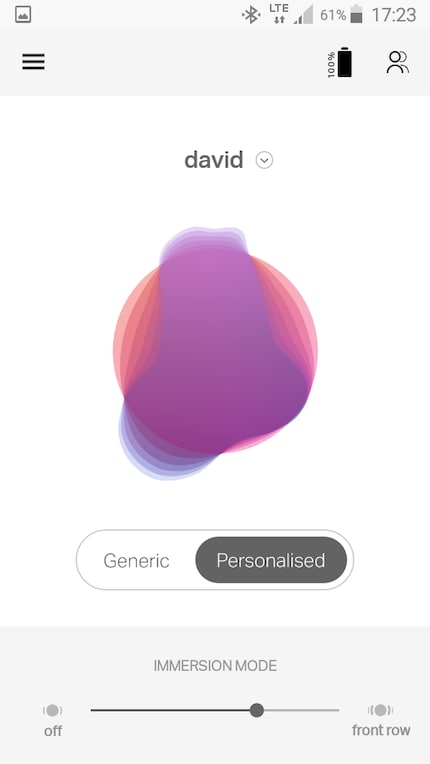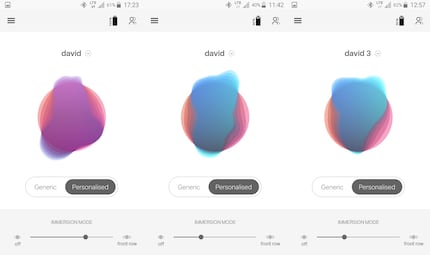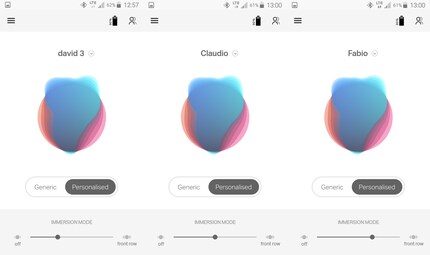

Nuraphone: the intelligent headset
Today's test: an unusual headset. It's undoubtedly innovative, but is it really that practical for everyday use?
The nuraphone, invented by Leberecht von Nurensdorff (1814-1899), was the ancestor of the gramophone. It made it possible to flatten the drums of music boxes to make discs.
Okay, enough of the pleasantries. We're talking here about a headphone called the Nuraphone, a headphone that represents a fine technological advance in 2018.
The Nuraphone, kézako?
The Nuraphone is a headset like none I've seen before. It's a hybrid between in-ear headphones and over-ear headphones. It fits into the ear canal while covering the ear. What does it do? I suppose it's a very effective way of reducing ambient noise. We'll have a look at that straight away.

The headphones also create an individual profile of your ear and adapt the sound accordingly. To do this, you need an app.

Voices in your head - setting up the headphones
I put on the headphones to see, immediately a synthesised female voice tells me in English that I need to connect my headphones to an Android or iOS device via Bluetooth. I do so. The voice sounds like the HintTron3000™ straight out of the retro adventure game Thimbleweed Park. It now tells me to download and install the Nura app. I comply once again. As it takes a bit of time, she tells me again and again.
The app is installed and asks me for an email address. This will be used to send me a security code, which I then enter into the app. As my emails arrive in waves, every five minutes, and therefore late, I first find myself faced with a desperately empty mailbox, then I suddenly receive several codes that are no longer valid. A quarter of an hour later, I finally manage to register.
I can finally move on to configuration. My hearing profile is automatically set up and it's pretty quick. The app plays mysterious sounds that remind me of 80s video games.
What does the headset measure?
What does the headset measure? Nuraphone explains how the headset works on its website. As I understand it, the headphones use sound reflections to measure my inner ear and eardrums and determine which frequencies I hear well and which I hear less well. The app then builds a profile to balance the sound.

I can now navigate between my personalised profile and the standard profile, but also choose different levels of immersion. This feature is supposed to give the impression of being in the middle of a live concert. I guess it's mostly just another name for the Bass Boost feature. I can also choose the function of the touch buttons on the left and right of the headphones: pause, next track or take a call, for example. It's also possible to disable them to avoid inadvertent use.
My impression
The standard profile (called "Generic") is completely different from my personal profile. The Generic profile diffuses mainly mid-range frequencies, there is little bass and treble, the sound is a bit hollow. My personalised profile is just the opposite: there are lots of highs and lows, and almost no mid-range frequencies. The slider for choosing the immersion level also increases the bass, so much so that my ears are still shaking.
I wouldn't go so far as to say that the custom profile is always better. For some tracks, which already emphasise bass and treble, the standard profile is more enjoyable. As a general rule, I still prefer the custom profile. But I set the immersion to a minimum, I'm not a big fan of excessive bass.
You can set up to three different profiles on the same set of headphones. Two of my colleagues have also created their profiles, and I've tested them. For me, my profile sounds the best. This proves that Nura doesn't just want to throw smoke and mirrors at us, but has created a measurement method that really works.
As my phone doesn't support aptx technology, the sound quality via Bluetooth is frankly not fantastic. On the other hand, when I plug the headphones into my PC with the USB cable that comes with them, I get very good quality sound effortlessly. Both profiles sound much better. The rest doesn't work so well on the PC: as soon as I plug in the cable, the headphones lose the connection with my phone. So when I listen to music from my PC, I can no longer choose the listening profile or other options. The headphones recharge via USB when plugged into the PC. It turns on and off automatically when plugged in/unplugged. [[image:14717195 "The USB cable is included. For other cables, a jack for example, it's up to you to buy them."]]
The soundproofing is very good. When I'm writing, the volume can get very high at times, but it becomes just background noise for me and I can concentrate on what I'm writing without any problems.
There is one little thing that bothers me a lot though. After 15 minutes maximum, the headphones start to hurt my right ear. There is only one size for the silicone tips. If they don't fit, too bad for you.
On standby the battery lasts for a week without a problem. But what about autonomy in use? It wasn't so easy to test: as I said earlier, the headphones hurt my ear after a few minutes and I can't leave them on and put them next to each other, so they switch off automatically. But I'm going to have to get on with it. Determined, so I prepare to listen to music until my ears bleed.
After half an hour of live weather, the damn battery is still at 100%. Nuraphone advertises a battery life of 15 to 20 hours. An hour has gone by and the battery is now showing 90%. So it's only diminishing in steps of 10%. Two hours and still 90%. I deduce that the autonomy announced by the manufacturer is plausible, or at least not totally unrealistic.
Conclusion
The headphones sound very good, but given the price, we wouldn't expect anything less. Other positives: the combination of over-ear and in-ear gives both great bass and very good attenuation of ambient noise.
I wouldn't go so far as to recommend the headphones, however. Because if it turns out that, like me, the headphones hurt you, that's like throwing CHF 400 out of the window. Nor can I guarantee that your personal listening profile as determined by Nuraphone will really appeal to you.
Update
After writing this report, I decided to create my profile again. The result was graphically completely different. As there was a bit of noise around me on the second try, I tried a third time. Here I was, completely confused.

I realised that my profile was very similar to those of Claudio and Fabio, two of my colleagues at digitec. What I see now only confuses me even more.

In this case, the display must be wrong, because the profiles sound very different. What bothers me most is the fact that one and the same person can generate such different profiles. I suppose it has something to do with the fact that the headphones aren't always positioned exactly the same way in the ear. I try twice more. I now have three personalised profiles, which I can switch between. They're not identical, but they look the same and sound the same. So the method works to a certain extent, the differences can be explained by the position of the headphones in the ear. And the first profile, completely different from the others, is certainly the result of a bug in the display.

If you've also tried out Nuraphone's custom profiles, feel free to share your experience in the comments. Thank you!
My interest in IT and writing landed me in tech journalism early on (2000). I want to know how we can use technology without being used. Outside of the office, I’m a keen musician who makes up for lacking talent with excessive enthusiasm.